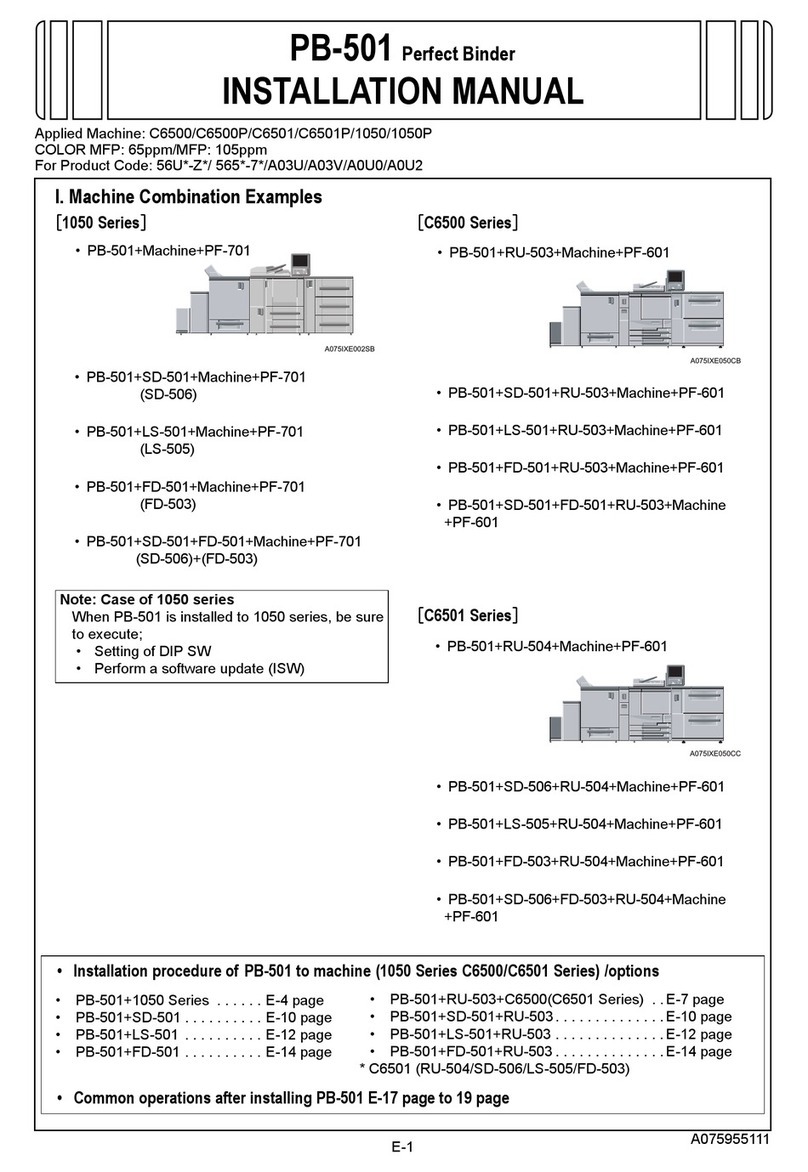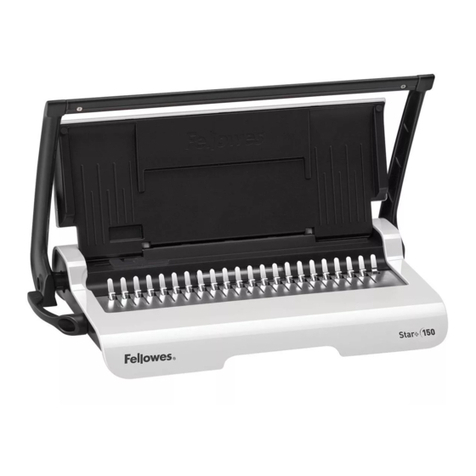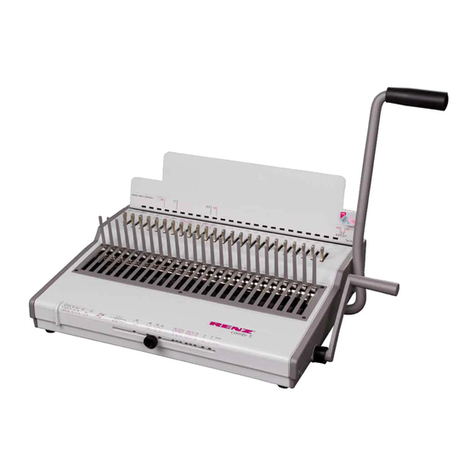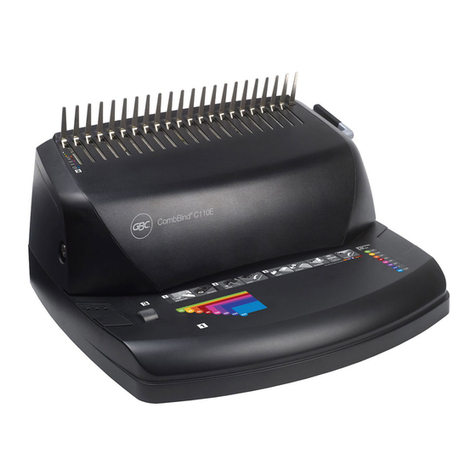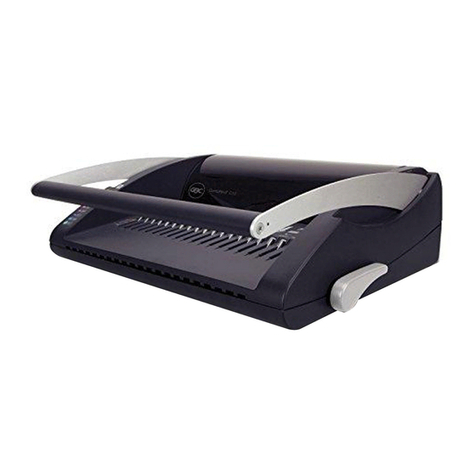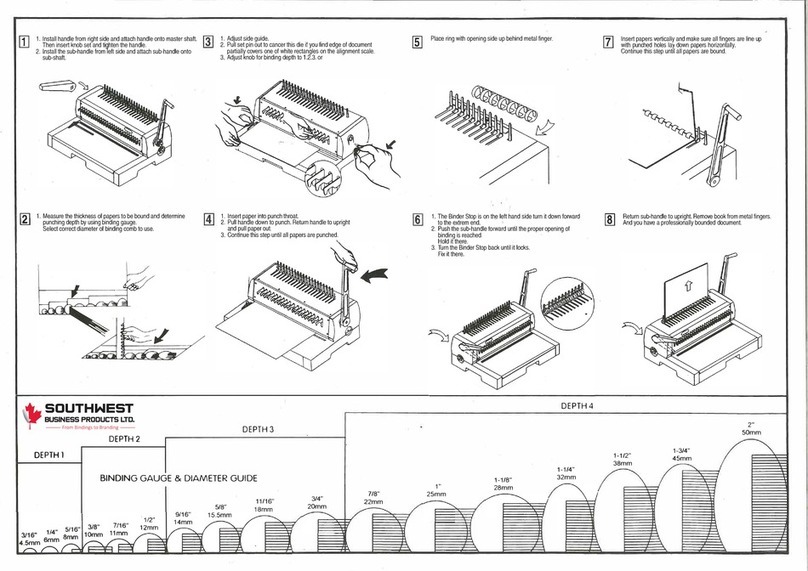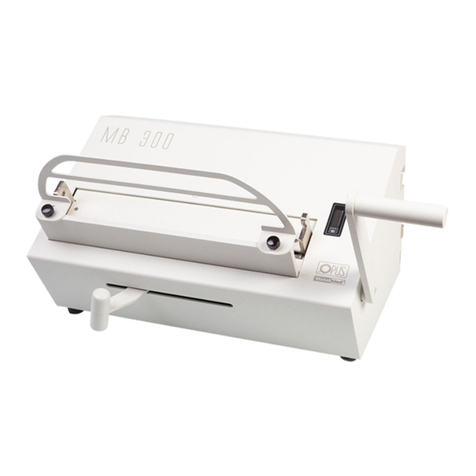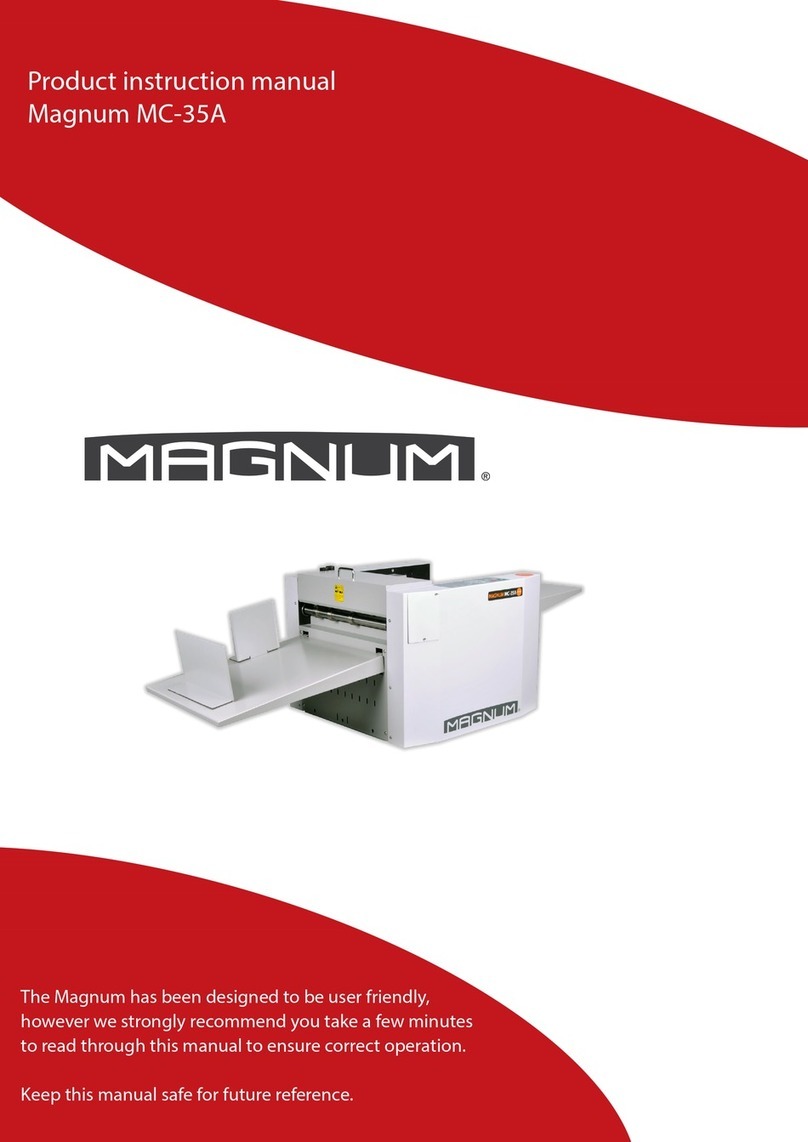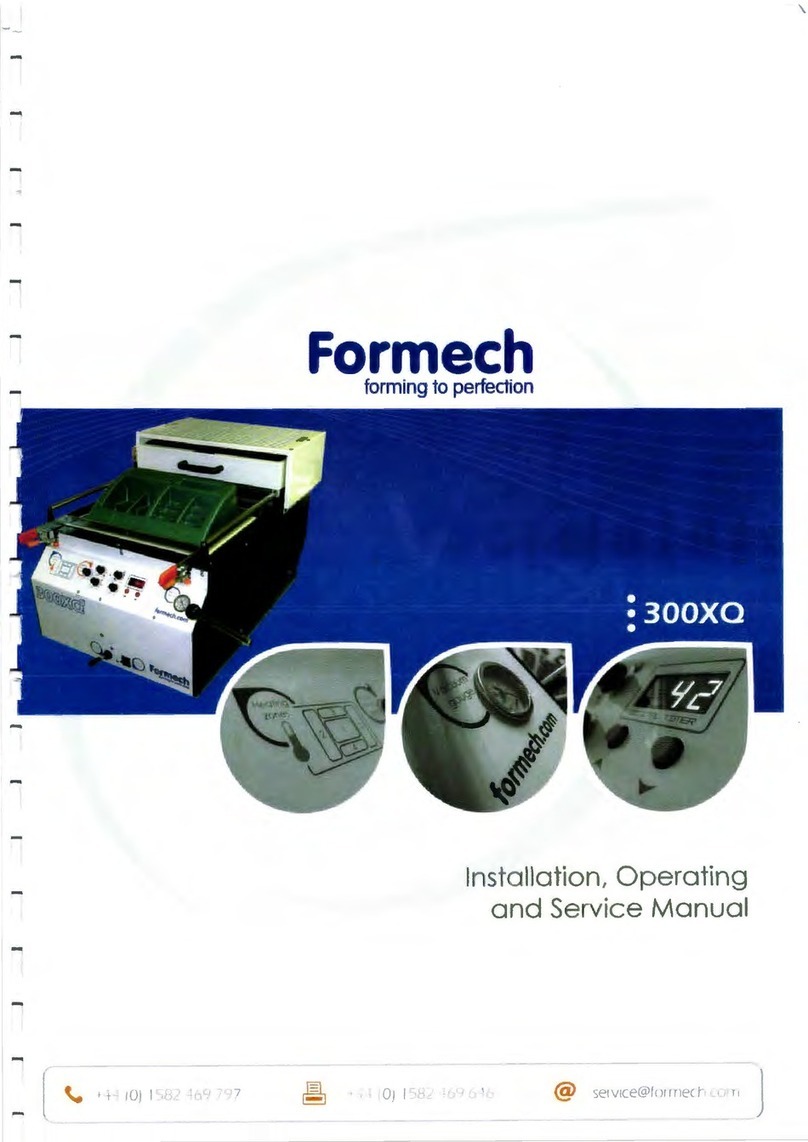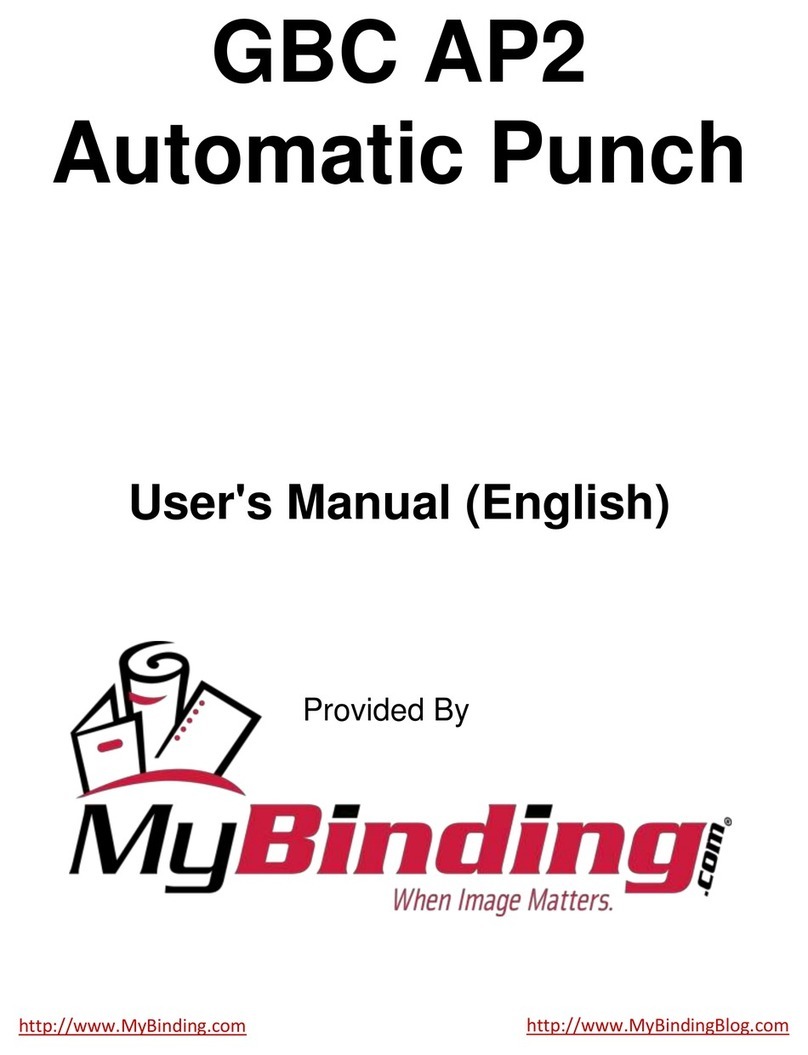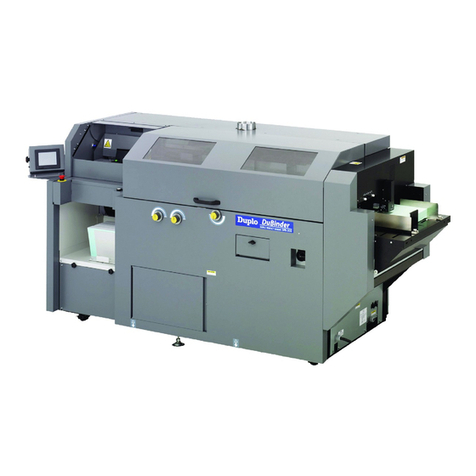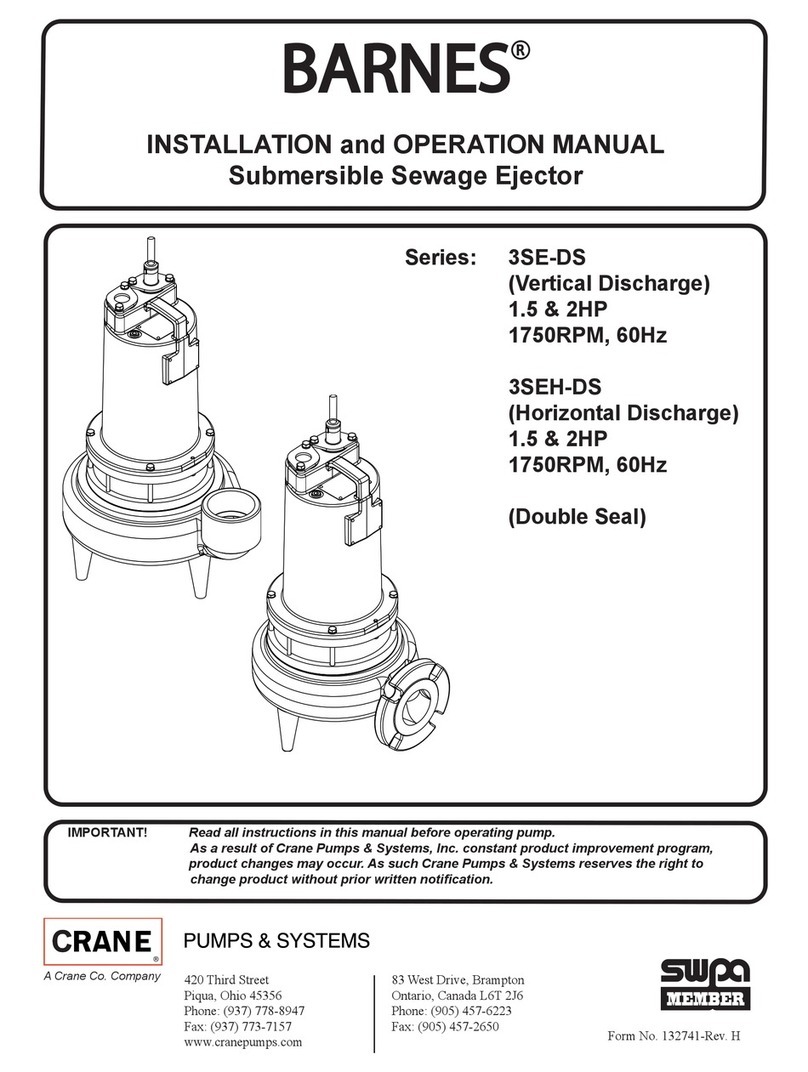Konica Minolta GBC PUNCH G2 Administrator Guide

PUNCH G2
GB Operation Instructions Manual
F Manuel d'instructions et d'utilisation
E Manual de instrucciones de operación
I Manuale d’istruzioni
D Bedienungsanleitung
NL Gebruiksaanwijzing
PT Manual de instruções de operação
RU Руководство по эксплуатации
CHI
操作使用手册
Part Number: 7718804
Revision number: A1
Issue Date: May 2017

PUNCH G2
English 3
Français 13
Español 23
Italiano 33
Deutsch 43
Nederlands 53
Português 63
На русском языке 73
中文 83
GB Please read these instructions carefully and keep them in a safe place for future
reference.
F Lisez attentivement le présent manuel et conservez-le en lieu sûr afin de pouvoir le
consulter en cas de besoin.
E Lea estas instrucciones cuidadosamente y manténgalas en un lugar seguro para consulta
en el futuro.
I Si prega di leggere attentamente le presenti istruzioni d'uso e di conservarle a portata di
mano per ogni ulteriore consultazione.
D Bitte lesen Sie diese Bedienungsanleitung sorgfältig durch und bewahren Sie sie als
Referenz für die Zukunft an einem sicheren Ort auf.
NL Lees deze gebruiksaanwijzing aandachtig door en bewaar deze op een veilige plaats voor
later.
PT Leia atentamente estas instruções e mantenha-as em um lugar seguro para futuras
consultas.
RU Внимательно прочтите все руководство и сохраните его на будущее.
CHI 请仔细阅读本手册,并将其保存在安全位置供日后参考。

3
EN
PUNCH G2
TABLE OF CONTENTS
1. SAFETY INSTRUCTIONS 3
Important safeguards 3
Cleaning 3
Service 4
Safety messages 4
2. INTRODUCTION 4
3. QUICK START GUIDE 5
4. USER OPERATIONS 6
1. SAFETY INSTRUCTIONS
THE SAFETY OF YOU AND OTHERS IS VERY IMPORTANT TO
GBC. IMPORTANT SAFETY MESSAGES AND INFORMATION ARE
CONTAINED IN THIS MANUAL AS WELL AS ON THE MACHINE
ITSELF. PLEASE MAKE SURE YOU CAREFULLY READ AND
UNDERSTAND ALL OF THESE BEFORE OPERATING THE
MACHINE.
THE SAFETY ALERT SYMBOL PRECEDES EACH SAFETY
MESSAGE IN THIS OPERATION INSTRUCTIONS
MANUAL. THIS SYMBOL INDICATES A POTENTIAL
PERSONAL SAFETY HAZARD THAT COULD HURT YOU
OR OTHERS.
THE FOLLOWING PICTORIAL IS FOUND ON THE PUNCH G2:
This safety symbol means that you might get
seriously hurt or killed if you open the product
and expose yourself to hazardous voltage.
NEVER remove the screwed on covers.
ALWAYS refer service requirements to
qualified service personnel.
5. USERDISPLAY 7
6. PROBLEM SOLVING 9
7. SPECIFICATIONS 9
8. DIE SET USER MANUAL 10
Important safeguards
Use the PUNCH G2 only for its intended purpose of punching
paper and covers according to the indicated specifications.
Retain this Operation Instructions manual for future use.
CAUTION: THE PRINTER ON/OFF SWITCH DOES NOT
CUT OFF POWER FROM THE PUNCH.
The PUNCH G2 must be connected to a supply voltage
corresponding to the electrical rating of the machine operation
instructions (also listed on the serial number label).
The grounding plug is a safety feature and will only fit into the
proper grounding-type power outlet. If you are unable to insert the
plug into an outlet, contact a qualified electrician to have a suitable
outlet installed.
Do not alter the plug on the end of the cordset (if provided) of the
PUNCH G2. It is provided for your safety.
Unplug the PUNCH G2 before moving the machine or whenever
the machine is not in use for an extended period of time.
Do not operate the PUNCH G2 if the machine has a damaged
power supply cord or plug. Do not operate the machine after any
malfunction. Do not operate the machine in case of liquid spills, or
if the machine has been damaged in any other way.
Do not overload electrical outlets beyond their capacity. To do so
may result in fire or electrical shock.
Cleaning
You may clean the exterior of the PUNCH G2 using a soft, damp
cloth.
Do not use detergents or solvents as damage to the machine may
occur.

4
EN
PUNCH G2
Safety messages
MAIN CORDSET SELECTION
(THE FOLLOWING NOTE ONLY APPLIES ONLY TO THE UNITS
RATED 230V 50Hz, AND LOCATED IN THE EUROPEAN UNION)
CAUTION: WHEN CHOOSING A DETACHABLE LINE
CORD FOR USE WITH YOUR PUNCH G2, ALWAYS
FOLLOW THE FOLLOWING PRECAUTIONS
The cordset consists of three parts: the attachment plug, the cord and
the appliance inlet. Each of these components must have European
regulatory safety approvals.
The following minimum electrical ratings for the specific cordset are
published for safety purposes.
DO NOT USE CORDSETS THAT DO NOT MEET THE FOLLOWING
MINIMUM ELECTRICAL REQUIREMENTS.
PLUG: 3 amperes, 250 volts, 50/60 Hz, Class 1, 3 conductor,
European safety approved.
CORD: Type H05VV-F3G0.75, Harmonized (< HAR >). The “< >”
symbols indicate cord approved according to appropriate European
standard (NOTE: “HAR” may be substituted for approval mark of
European safety agency that approved the cord. An example would be
“< VDE >”).
APPLIANCE CONNECTOR: 3 amperes, 250 volts, 50/60 Hz,
European safety approved, Type IEC 320. The cordset shall not
exceed 3 meters in length. A cordset with component electrical ratings
greater than the minimum specified electrical ratings may be
substituted.
Service, PUNCH G2
Do not attempt to service your PUNCH G2 yourself. Contact an
authorized service representative for any required repairs or major
maintenance for your PUNCH G2.
DO NOT REMOVE THE MACHINE’S COVER.
There are NO user-serviceable parts inside the machine in order to
avoid potential personal injury and/or damage to property or the
machine itself.
Service, Diesets
Every dieset is thoroughly oiled at the factory prior to shipping. Please
note that it is normal for oil to be present on the first few punched
sheets. During normal use this oil will be exhausted and should be
replaced. As part of regular maintenance, each dieset should be oiled
after approximately 250K punch cycles or sooner. GBC recommends
use of brand 3-IN-ONE oil as it is readily available. Other light machine
oils can also be used.
To oil the dieset, refer to Section 8- Die Set User manual. Please note
that it is normal for oil to be present on the first set of sheets punched
after oiling the dieset. After approximately 25 to 50 sheets oil will no
longer be found on the punched sheet. At this time the PUNCH G2 can
be utilized for punching of print jobs.
Refer to Section 8 - Die Set User manual for detailed cleaning
instructions of the crease die.
See Section 8 PUNCH G2 Dieset Manual for further instructions on
servicing the Diesets.
Safety messages
FCC NOTE
(THE FOLLOWING NOTE ONLY APPLIES TO THE UNITS RATED
115V 60Hz.)
This equipment has been tested and found to comply with the limits for
a Class A digital device, pursuant to Part 15 of the FCC Rules. These
limits are designed to provide reasonable protection against harmful
interference when the equipment is operated in a commercial
environment.
This equipment generates, uses, and can radiate radio frequency
energy and, if not installed and used in accordance with the Operation
Manual, may cause harmful interference with radio communications.
Operation of this equipment in a residential area is likely to cause
harmful interference in which case the user will be required to correct
the interference at his/her own expense.
CAUTION: CHANGES OR MODIFICATIONS NOT
EXPRESSLY APPROVED BY GENERAL BINDING
CORPORATION COULD VOID YOUR AUTHORITY TO
OPERATE THE EQUIPMENT.
2. INTRODUCTION
Thank you for purchasing the PUNCH G2. It is a versatile production
system that will enable you to punch documents for a variety of binding
styles by means of a simple die change. It has also been designed for
easy operation.
The PUNCH G2 is an innovative solution for punching paper and offers
the following design features:
Quick-change die sets that can be interchanged without any tools.
All PUNCH G2 die sets include an Identification Label providing
the user with the hole pattern and name.
Convenient storage area for two extra Die Sets located above the
sheet bypass.
Duty Cycle and Product Positioning
The GBC PUNCH G2 provides a flexible, cost effective punching
solution for light to medium level punching production environments. It
is designed for production print users that typically punch their
documents at an average of 20-30% of their overall workflow. For
customers that run continuous punching for long runs of over 4 hours,
performance may vary or degrade due to a wide range of media
weights and environmental conditions that can occur.
Maximum Recommended Monthly Volume - The maximum
recommended monthly punch volume should NOT exceed 400,000.
Operating Die Set Supplies
Dies are considered consumables and when worn, must be replaced
since sharpening is not possible.
Each die set has a 90-day warranty from the date of purchase. The
warranty is void if the die is used beyond its specifications.
Punch die life will be maximized if oiled every 100,000 punch cycles
(see Dieset Service for details)
Die sets have an expected use life of 750,000 punches using
20 lb/75 gsm paper. This is a minimum life expectation only. Die life is
NOT guaranteed due to a wide range of media weights and
environmental conditions that the dies may endure. If you are going to
be punching extended runs that exceed the die use life, it is strongly
recommended that you have sufficient numbers of the appropriate die
sets on hand to continue with minimal downtime.

5
EN
PUNCH G2
3. QUICK START GUIDE
PUNCH G2 must be connected to AC power to enable any feature
of the machine. Below are three modes of operation of PUNCH G2.
1. Bypass Mode:
This operation will allow paper to pass through the PUNCH G2
without being punched.
This is the default mode of operation for PUNCH G2. Make sure
the Punch Icon is not selected in the printer’s User Interface.
2. Single Punch Mode:
This operation will punch the trail edge of all sheets that pass
through the PUNCH G2.
Step 1: A properly configured die set must be inserted before
running punch mode. See section 4.A for details on Die set
changes and follow the labels on the die set for configuration.
Step 2: Before starting a print job select the Punch mode from
the printer’s UI.
PUNCH G2 will now function in Single Punch mode.
3. Double Punch Mode:
This operation will punch the two rows of holes- One in the middle
of the sheet and the other adjacent to the trail edge of all sheets
that pass through the PUNCH G2.
Step 1: A properly configured die set must be inserted before
running punch mode. See section 4.A for details on Die set
changes and follow the labels on the die set for configuration.
Step 2: Before starting a print job enable Double Punch from
the printer.
PUNCH G2 will now function in Double Punch mode.
Layout of PUNCH G2 LCD User Interface
4. Die Set Configuration:
To configure the Die Set for the desired sheet size that is being
processed see section 8 –Die Set User Manual.
5. Restrictions:
I. Using clear cover other than 7 mil may cause a jam to occur
and could require a service call.
II. When punching 300gsm paper or above, with grain direction
in the long orientation, paper jams may occur. The problem
may not occur with the grain direction in the short
orientation.
UP
DOWN
ENTER

6
EN
PUNCH G2
4. USER OPERATIONS
A. Interchanging Die Sets:
Are completed without tools and only take seconds to perform
B. Punch Chip Container:
Easy-to-access chip tray for quick chip disposal
C. Die Set Storage:
Holds up to 2 spare Die Sets
D. Punch Bypass:
Short straight-through paper path for unpunched documents
E. Punch Mode Path:
Wide radius turn can support stocks up to 300g/m2 cover
Paper flow and User Interactive sections of PUNCH G2
A. Interchanging Die Sets:
Your PUNCH G2 offers the convenience of interchangeable die sets,
allowing you to economically punch documents for a wide variety of
binding styles. Changing the machine's die sets is both quick and easy,
as the following instructions illustrate:
Note: For advanced Die Set Configuration instructions- See Section 8
Die Set User Manual.
Removing Die Sets from the Machine: The inter-changeable die set
slot of the PUNCH G2 is located adjacent to the Punch Chip container
at the bottom of the punch.
Step 1: Stop the printer/copier.
Step 2: Open the PUNCH G2 access door panel.
Step 3: Securely grasp the die lock handle and rotate it in the
CCW direction, as indicated in the label near the die lock handle.
This releases the die from the locked position.
Step 4: Slide the die set out until it is fully removed, supporting it
with both hands.
Step 5: Properly store the removed Die Set in the Die Set storage
area of the PUNCH G2 (keep away from dust, dirt, accidental falls
from the edge of counters, etc.).
Step 6: Select the desired Die Set for your new job and slide it into
the Die Set slot. Push the Die set firmly until the Die stop feature
contacts the round magnet. This is critical in ensuring the proper
position of the punch die set.
Step 7: Grasp the handle and rotate it in CW direction until the
latch is fully engaged, as shown indicated in the label.
WARNING: POSSIBLE PINCH POINT HAZARD. WHEN
INSTALLING DIE SETS IN YOUR PUNCH G2, ALWAYS
KEEP FINGERS AND OTHER BODY PARTS OUT OF THE
MACHINE’S DIE SET SLOT AND AWAY FROM ALL AREAS
OF THE DIE SET, EXCEPT FOR THE FINGER HOLE IN THE
DIE SET. FAILURE TO FOLLOW THESE PRECAUTIONS
MAY RESULT IN INJURY.
Step 8: Close the Access Door Panel.
Step 9: Proceed with your printing and punching/creasing job.
Please note that when using a new die some oil will be present around
the punched holes on the sheet. After punching 25 to 50 sheets the die
will no longer leave oil on the sheets. It is recommended that a short
test print job be run after installing a new die or a die that has recently
been oiled.
B. Punch Chip Container:
The Punch Chip Container for your PUNCH G2 is located at the front of
the machine’s base. The drawer should periodically be pulled out and
emptied. The PUNCH G2 uses a sensor to determine when the punch
container is full. Once the punch container becomes full the LCD
display shows "Chip Tray Full" message and a message also appear
on the printers user interface screen.

7
EN
PUNCH G2
C. Paper Clearing:
When paper is jammed in the paper path of
PUNCH G2 the LCD display shows the area
where a sheet(s) is jammed.
Area
Description
Zone 1
If paper is jammed in Zone 1, lift the paper guide
plate located just inside, reach and remove the
jammed paper. To close the paper guide, raise
the handle to unlatch the mechanism and firmly
close it.
Zone 2
If paper is jammed in the downward paper chute,
move the chute to the right, reach in and remove
the jammed paper.
Ensure the paper chute is closed.
Zone 3
If paper is jammed in the right bottom chute, press
the top lever while holding the bottom lever. This
will unlatch the chute; continue to open the chute
until it reached the magnet on the right side. Reach
in and remove the paper. To return the chute to the
closed position, move it back in the opposite
direction until the latch mechanism is activated.
Ensure the paper chute is closed.
Zone 5
If paper is jammed in the left bottom chute,
unlatch the chute, reach in and remove any
jammed paper.
Ensure the paper chute is closed.
Zone 6
If paper is jammed in the upward paper chute,
move the door to the left, reach in and remove the
jammed paper.
Ensure the paper chute is closed.
Zones 3 and 5
Before uninstalling the die set, ensure zone 3 and
5 are cleared of any jammed paper. If there is
jammed paper that cannot be removed from
zones 3 and 5, uninstall the die set to remove the
jammed paper. (see Section 4. Changing the
Interchangable die sets).
5. USER DISPLAY . OPERATION CONTROLS
Located on the front of the PUNCH G2 is a user interactive LCD panel
that provides Messages; Settings and Information relating to the
functions of the punch unit.
LCD Panel Overview
Messages on the LCD Panel
1. Ready Bypass
PUNCH G2 is ready to bypass, sheets will not be punched.
2. Ready Single Punch
PUNCH G2 is ready to process a punch job, all sheets through the
unit will be punched.
3. Ready Double Punch
PUNCH G2 is ready to process a punch job, all sheets through the
unit will be punch in the middle of sheet and along trail edge of the
sheet.
4. Running Bypass
This is displayed when Bypass mode is in operation.
5. Running Single Punch
This is displayed when Single punch mode is in operation.
6. Running Double punch
This is displayed when Double punch mode is in operation.
7. Chip tray Full
When the punch container becomes full of waste paper chips, this
message will be displayed.
8. Chip tray Out
When the punch container is removed or not fully inserted into the
punch unit, this message will be displayed.
9. Check die
When the Die Set is removed or not fully inserted into the punch
unit, this message will be displayed. When this message is
displayed the punch unit will run in Bypass mode only.
10. Close Door
When the Front door is open or not completely closed this
message will be displayed.
11. Paper jam
When a sheet of paper becomes jammed within the punch unit,
this message is displayed. See the section of this manual titled
PAPER CLEARING for instructions on how to remove a jammed
sheet.
LCD User Interface Screen Overview
MAIN SCREEN
SETTINGS INFORMATION
BACKGAGE ALIGNMENT CLEAR COVER LANGUAGE UNITS DIE
TYPE DIE
CYCLES PUNCH
CYCLES
Options:
TRAIL
MID L
MID XL
Options:
CC BACKGAGE
CC ALIGMENT
Options:
DEUTSCH
ENGLISH
ESPANOL
FRANCAIS
ITALIANO
Options:
MM
IN
FIRMWARE

8
EN
PUNCH G2
Changing the Settings on the LCD panel
1. Backgage Depth Setting
Backgage is the distance of the punched hole(s) from the trail
edge of the sheet. This distance can be adjusted by entering the
Settings section (press Up or Down from the Home screen, and
press OK for Settings).
Pressing Up arrow will increase the Depth of Backgage, and
Pressing Down arrow will decrease the Depth of Backgage.
The settings for backgage MID L and MID XL adjust the backgage of
the double punch mode. MID L and MID XL function the same as the
regular backgage depth, but adjust the position of the middle punch.
MID L adjusts backgage for SEF letter and SEF A4, while MID XL
adjusts backgage for SEF 11x17 and A3
2. Alignment Setting
Alignment is the distance of the Top punched hole from the side
edge of the sheet (viewed from the punch output orientation). This
distance can be adjusted by entering the Settings section (press
Up or Down arrow from the Home screen, and press OK for
Settings). Pressing Up arrow will increase the Alignment position,
and Pressing Down arrow will decrease the Alignment position.
3. Clear Cover
Use this setting to adjust the Backgage depth and Alignment
setting for Clear Cover media. Adjusting this offset does not affect
the Backgage and Alignment settings of other media types.
4. Language
The LCD panel can be configured to display one of the following
languages: English; Francais; Espanol; Deutsch or Italiano.
5. Units
The LCD panel can be configured to display units in MM or
Inches.
Displaying Information on the LCD Panel
1. Die type
This is type of die-set currently installed in the punch.
2. Die cycles
This is the total number of sheets punched with the currently
installed die-set.
3. Punch cycles
This is the total number of punched sheets the system has
processed.
4. Firmware
This displays the current level of firmware of PUNCH G2.
“-” ON THE LCD
DECREASES
BACKGAGE
DEPTH
“+”ON THE LCD
BACKGAGE
INCREASES
BACKGAGE
DEPTH
BACKGAGE
“-” ON THE LCD
DECREASES
BACKGAGE
DEPTH
“+”ON THE LCD
INCREASES
BACKGAGE
DEPTH
ALIGNMENT
INCREASES
ALIGNMENT
OFFSET
“-” ON THE LCD
“+” ON THE LCD
DECREASES
ALIGNMENT
OFFSET

9
EN
PUNCH G2
6. PROBLEM SOLVING
Problem
Probable Cause
No power, won’t punch
Power cord not attached to back
of machine or not properly
plugged into the wall.
Power On/Off Switch not
activated.
Punched holes not aligned with
the edge of the paper
Follow instructions on die set
labels to properly configure the
die for a specific sheet size.
Sheet jamming repeatedly at die
set area.
Remove the die-set, inspect the
die throat to see if there is any
stuck paper chad.
Insert Chip tray message on the
LCD interface.
Make sure the Chip tray is fully
inserted.
7. SPECIFICATIONS
Speed
Up to 136 sheets per minute
Punch Sheet Size and
Edge
LEF- Long Edge Fed
SEF- Short Edge Fed
Tab Stock
US Sizes
LTR LEF
LTR SEF
LTR SEF Double Punch
Statement LEF
Legal SEF
Ledger SEF
Ledger SEF Double Punch
ISO sizes
A4 LEF
A4 SEF
A4 SEF Double Punch
A5 LEF
A3 SEF
A3 SEF Double Punch
US Sizes
LTR, with 3,4,5,8 and 10 tabs
Statement, with 3 and 5 tabs
ISO Sizes
A4, with 5 and 10 tabs
A5, with 3 and 5 tabs
Paper Stock
Clear Cover
Plain: 75gsm - 300gsm
(20# bond to 110# cover)
Coated: 120gsm - 300gsm
(32# bond to 110# cover)
7mil
Bypass mode stock and
sizes
Paper sizes and stocks same as
printer
Punch Capacity
Single Sheet
Power Supply
115V, 60Hz, Single Phase
230V, 50Hz, Single Phase
Electrical
Amps and
Frequency
115V; 3.8A; 60Hz (or)
230V; 1.9A; 50Hz
Safety Certification
cULus
Dimensions
L: 775mm; W: 445mm; H: 1020mm
L: 30.5"; W: 17.5"; H: 40.2"
Weight
95 kg
210 lbs
Shipping Weight
123 kg
272 lbs.
Manufactured
Assembled in Taiwan

10
EN
PUNCH G2
8. DIE SET USER MANUAL
The die sets for the PUNCH G2 are intended to work with multiple
paper sizes and sheet feed directions. In order to accommodate
different sheet sizes this die set must be configured to the correct
number of punching pins and the die stop must be set to the proper
position. The die label contains information on the common paper
punching sizes, for the uncommon sizes please refer to Table 8.1.
Glossary
LEF- Long Edge Feed- Indicates that the paper is being fed through
the machine so that the longer side of the sheet will be punched.
SEF- Short Edge Feed- Indicates that the paper is being fed through
the machine so that the shorter side of the sheet will be punched.
Statement Paper- 8.5" X 5.5"
Legal Paper- 8.5" X 14"
Ledger Paper- 11" X 17"
Pin Numbering
Die punching pins are numbered sequentially starting from the handle
end. Figure 8.1 shows a 47 hole coil die as an example. All square and
round hole die sets follow the same pin numbering format.
Figure 8.1 Coil Die Set Pin Numbering
Figure 8.2 Pressure Bar Removal
To remove punch pins from the PUNCH G2 first turn the two Quarter
Turn Fasteners CCW direction to release the pressure bar. Remove
the pressure bar and set aside.
Figure 8.3 Pressure Bar
Figure 8.4 Pin Removal
Note:Lubricating oil may be present on the die pins, wear gloves if
needed.
Lift up and remove the desired pins according to Table 8.1. Store pins
in the pin storage tray inside front door of machine making sure pins
cannot be dropped, damaged or lost while removed.
Figure 8.5 Replace Pressure Bar
Replace the pressure bar by lining up dowel pin holes with exposed
dowel pins. Hold pressure bar so that it is seats completely over dowel
pins and then rotate Quarter Turn Fasteners clockwise until a click is
felt to lock pressure bar in position. The pressure bar can be locked
only if the orientation is correct, it cannot be locked in any other
orientation.
Important!
Before reinserting, clean the punch pin to remove any dust or foreign
substances.
Make sure pressure bar is attached and both Quarter Turn Fasteners
are in the locked position prior to inserting the die set into the machine
or serious damage can occur to both the machine and die set.
Pin #1
Pin #47
Quarter Turn
Fastener
Pin Removal
Coil
Rnd
Wire
2:1
Rnd
Wire
3:1
Rnd
3 Hole
8mm
3/5/7
Hole
8mm
2/4
Hole
8mm
2/4
Hole
6.5mm
2/4
Hole
SCAN
VeloBind
11 Hole
LTR
VeloBind
12 Hole
A4
CombBind
Wire
2:1
Sq
Wire
3:1
Sq
US Paper Sizes
Pin Numbers to Remove Based On Paper Size or Orientation
Konica Minolta Part Number
LTR LEF
2, 47
1, 23
1, 34
NONE
3H/5H/7H
N/A
N/A
N/A
NONE
N/A
1, 21
1, 23
1,34
LTR SEF
7, 42
NONE
5, 31
N/A
N/A
N/A
N/A
N/A
N/A
N/A
NONE
NONE
5,31
STATEMENT LEF
7, 42
NONE
5, 31
N/A
N/A
N/A
N/A
N/A
N/A
N/A
NONE
NONE
5,31
LEGAL SEF
7, 42
NONE
5, 31
N/A
N/A
N/A
N/A
N/A
N/A
N/A
NONE
NONE
5,31
LEDGER SEF
2, 47
1, 23
1, 34
NONE
3H/5H/7H
N/A
N/A
N/A
NONE
N/A
1, 21
1, 23
1, 34
9" x 12" LEF
1, 2, 47
1, 23
1, 34
NONE
3H/5H/7H
N/A
N/A
N/A
NONE
N/A
1, 21
1, 23
1, 34
9" x 12" SEF
6, 7, 42, 43
3, 21
5, 31
N/A
N/A
N/A
N/A
N/A
N/A
N/A
3, 19
3, 21
5, 31
12" x 18" SEF
1, 2, 47
1, 23
1, 34
NONE
3H/5H/7H
N/A
N/A
N/A
NONE
N/A
1, 21
1, 23
1, 34
Coil
Rnd
Wire
2:1
Rnd
Wire
3:1
Rnd
3 Hole
8mm
3/5/7
Hole
8mm
2/4
Hole
8mm
2/4
Hole
6.5mm
2/4
Hole
SCAN
VeloBind
11 Hole
LTR
VeloBind
12 Hole
A4
CombBind
Wire
2:1
Sq
Wire
3:1
Sq
ISO Paper Sizes
Pin Numbers to Remove Based On Paper Size or Orientation
Konica Minolta Part Number
A4 LEF
NONE
NONE
NONE
N/A
N/A
2H/4H
2H/4H
NONE
N/A
NONE
NONE
NONE
NONE
A4 SEF
7, 41
4, 21
5, 30
N/A
N/A
2H
2H
NONE
N/A
N/A
4, 19
4, 21
5, 30
A5 LEF
7, 41
4, 21
5, 30
N/A
N/A
2H
2H
NONE
N/A
N/A
4,19
4, 21
5, 30
A3 SEF
NONE
NONE
NONE
N/A
N/A
2H/4H
2H/4H
NONE
N/A
NONE
NONE
NONE
NONE
SRA4 LEF
NONE
NONE
NONE
N/A
N/A
2H/4H
2H/4H
NONE
N/A
NONE
NONE
NONE
NONE
SRA4 SEF
6, 7, 42, 41
4, 21
4, 5, 30, 31
N/A
N/A
N/A
N/A
NONE
N/A
N/A
4, 19
4, 21
4, 5, 30, 31
SRA3 SEF
NONE
NONE
NONE
N/A
N/A
2H/4H
2H/4H
NONE
N/A
NONE
NONE
NONE
NONE
*For CombBind 20H Configuration Pull Pin Number 1 Table 8.1 Pin Removal Guide
The above chart shows the information on which pins need to be removed to correctly punch each sheet size and configuration that the PUNCH G2 can
accept. For standard offering dies not found in the chart no pin adjustment is necessary.
Dowel Pin
Holes
Dowel Pin Holes

11
EN
PUNCH G2
Pin Addition
The process for adding punch pins is the same as pin removal except
that pins are added and not removed once the pressure bar is off.
When replacing punch pins make certain that the pins are completely
seated against the pin retainer prior to reattaching the pressure bar.
Figure 8.6 Pin Addition
Die Stop Position
On some of the PUNCH G2 die sets there is an adjustable die stop
which is used to re-center the die set for certain sheet sizes, as shown
in Figure 8.7. For die sets without a die stop knob there is no die stop
position adjustment necessary.
For units with a die stop knob, the die stop must be set to the correct
position or the punched holes will not be centered on the sheet. The
common paper sizes are shown on the die stop handle label below the
die stop knob, for the uncommon paper sizes please refer to Table 8.2.
Position A is when the arrow on the die stop knob points down towards
the handle and lines up with the lower arrow on the die stop handle
label. Position B is when the arrow on the die stop knob points to the
side and lines up with the side arrow on the die stop handle label. (See
Figure 8.7)
To change the die stop position first remove the die from the machine
and place on a flat stable surface. While holding the die in a stable
position push down on the die stop knob until the knob is free to rotate.
Then turn the knob until the arrow on the knob lines up with the desired
arrow on the die stop handle label. Once the arrows line up, release
the die stop knob making sure that the metal die stop on the bottom
fully seats against the die plate.
Coil
Rnd
Wire
2:1
Rnd
Wire
3:1
Rnd
CombBind
Wire
2:1
Sq
Wire
3:1
Sq
US Paper Sizes
Die Stop Position Based On Paper Size or Orientation
Konica Minolta Part Number
LTR LEF
B
A
A
A
A
A
LTR SEF
B
A
B
A
A
B
STATEMENT LEF
B
A
B
A
A
B
LEGAL SEF
B
A
B
A
A
B
LEDGER SEF
B
A
A
A
A
A
9" x 12" LEF
B
A
A
A
A
A
9" x 12" SEF
B
A
B
A
A
B
12" x 18" SEF
B
A
A
A
A
A
Coil
Rnd
Wire
2:1
Rnd
Wire
3:1
Rnd
CombBind
Wire
2:1
Sq
Wire
3:1
Sq
ISO Paper Sizes
Die Stop Position Based On Paper Size or Orientation
Konica Minolta Part Number
A4 LEF
A
A
A
A*
A
A
A4 SEF
A
A
A
B
B
A
A5 LEF
A
A
A
B
B
A
A3 SEF
A
A
A
A*
A
A
SRA4 LEF
A
A
A
A*
A
A
SRA4 SEF
A
B
A
B
B
A
SRA3 SEF
A
A
A
A*
A
A
*For CombBind 20H Configuration set to die stop position B
Table 8.2 Die Stop Position Guide
Figure 8.7 Coil Die Stop Position
Die Set Maintenance
The PUNCH G2 die set must be periodically oiled and greased to
maintain proper functionality and prevent premature failure of the die
set. The die set should be oiled and inspected every 100K cycles.
To lubricate die set pins that do not have felt pads:
1. Depress the die set so that the pins protrude from the bottom
plate.
2. Apply a drop of high quality machine oil to the end of each pin.
3. Wipe clean, leaving a light coat of oil on them.
To lubricate die set pins that have felt pads:
1. Lubricate with a high quality machine oil.
2. Apply oil lightly along the length of the pad [1], but do not over
saturate.
3. Do not use spray lubricants because they tend to dry up
quickly and leave a sticky residue.
Oil from the die may blemish the first few punched sheets after oil
has been applied. Run test punched copies until clean copies can
be made.
Figure 8.8 Lubrication
Die Set Shoulder Bolts
The die set shoulder bolts must be checked and lubricated as
necessary every 200K cycles. If the grease is missing from the springs
or shoulder bolts [2] then additional grease must be applied.
1. Lubricate with a high quality Teflon-based grease.
2. Apply grease to shoulder bolts and springs [2]
3. Wipe up any excess grease.
End of Die Life
If a die set is at the end of its life it will tend to cause paper jams due to
hanging paper chips. This is a result of die plate wear and not pin
wear, which cannot be corrected. When this occurs, the die set must
be replaced with a new one. Attempting to replace or sharpen pins will
not correct the issue since the wear is in the plates and therefore is not
recommended.
CORRECT INCORRECT
CORRECT INCORRECT
Die Stop
Handle Label
Die Stop Knob
Position A
Position B

12
EN
PUNCH G2
PUNCH G2 Die Sets
The PUNCH G2 uses a variety of easily interchangeable die sets that allow you to punch documents in line for several different binding styles. By
selecting the appropriate die set, you can use your PUNCH G2 to punch documents in any of the following binding styles. Heavy Duty (HD)die sets
are shown in bold where available.
Die Set Description
Part Number
For Plastic Comb Binding:
Die, Konica Minolta, Comb Bind
Die, Konica Minolta, Comb Bind, HD
7714911
PB Plastic Bind; Hole Size: 8mm x 2.9mm (0.313" x 0.116") (LxW); Center-to-Center Hole Spacing: 14.3mm (0.563")
For Twin Loop™ Binding:
Die, Konica Minolta, Wire 3.1, Sq.
7714913
W3 Wire; Square; 3 Holes per inch; Hole Size: 4mm x 4mm (0.156" x 0.156") (L x W); Center-to-Center Hole Spacing:
8.5mm (0.333")
Die, Konica Minolta, Wire 2.1, Sq.
7714912
W2 Wire; Rectangle; 2 Holes per inch; Hole Size: 6.4mm x 5.4mm (0.250" x 0.214")(L xW); Center-to-Center Hole Spacing:
12.7mm (0.500")
Die, Konica Minolta, Wire, 3:1, Rnd.
7714903
W3 Wire; Round; 3 Holes per inch; Hole Size: 4mm (0.158") Diameter; Center-to-Center Hole Spacing: 8.5mm (0.335")
Die, Konica Minolta, Wire, 2:1, Rnd.
7714902
W2 Wire; Round; 2 Holes per inch; Hole Size: 6.5mm (0.0.256") Diameter; Center-to-Center Hole Spacing: 12.7mm (0.5")
For Color Coil™ Binding:
Die, Konica Minolta, Coil, Rnd.
Die, Konica Minolta, Coil, Rnd, HD
7714901
7714917
C4 Coil; Round; 4 Holes per inch; Hole Size: 4.4mm (0.174") Diameter; Center-to-Center Hole Spacing: 6.3mm (0.2475")
Die, Konica Minolta, Coil, Oval
7714914
C4 Coil; Oval; 4 Holes per inch; Hole Size: 4mm x 5mm (0.158" x 0.197") (L x W); Center-to-Center Hole Spacing: 6.3mm
(0.2475")
For Velo®Bind:
Die, Konica Minolta, Velobind®, 11 Holes, Ltr.
7714909
VB Velobind®; Round; 1 Hole per inch Hole Size: 3.2mm (0.125") Diameter; Center-to-Center Hole Spacing: 25.4mm (1")
Die, Konica Minolta, Velobind®, 12 Holes, A4.
7714910
VB Velobind®; Round; 1 Hole per inch Hole Size: 3.2mm (0.126") Diameter; Center-to-Center Hole Spacing: 25.4mm (1")
For Loose Leaf Binding:
Die, Konica Minolta, 3 Hole, 8mm
Die, Konica Minolta, 3 Hole, 8mm, HD
7714904
7714918
3 Ring Binder; U.S. (Standard Loose-leaf Patterns); Hole Size: 8mm (0.316") Diameter
Die, Konica Minolta, 3/5/7 Hole, 8mm
7714905
3 Ring, 5 Ring, 7 Ring; U.S. (Standard Loose-leaf Patterns); Hole Size: 8mm (0.316") Diameter
Die, Konica Minolta, 4 Hole, 8mm
7714906
4 Ring Binder; European (Standard Loose-leaf Patterns); Hole Size: 8mm (0.315") Diameter
Die, Konica Minolta, 4 Hole, 6.5mm
7714907
4 Ring Binder; European (Standard Loose-leaf Patterns); Hole Size: 6.5mm (0.256") Diameter
Die, Konica Minolta, 4 Hole, Scan
7714908
4 Ring Binder; Scandinavian (Standard Loose-leaf Patterns); Hole Size: 6.5mm (0.256") Diameter
©2016 GBC, Lake Zurich, Illinois - All rights reserved. Graphics do not represent actual punch pattern dimensions or spacing.
* When the Plastic Comb binding die is used in the 21 hole configuration on A4 width paper (297mm), there is the potential for the outer edge of holes 1 and 21 to
be torn. The theoretical paper edge should be 1.62mm from the edge of the sheet. This event is dependent on paper type, paper width and hole alignment
optimization. To avoid this issue, it is recommended to use a 20 hole configuration instead. 20 hole comb binding supplies are commonly available from GBC and
other manufacturers and are considered more optimal than the 21 hole configuration.
121-A4
19-LTR
1 34-A432-LTR
123-A4
21-LTR
1 32-L 34-A4
TR
123-A4
21-LTR
147-A444-LTR
147-A444-LTR
1 11
1 12
13
17
4
1 4
1 4

13
F
PUNCH G2
TABLE DES MATIÈRES
1. CONSIGNES DE SÉCURITÉ 13
Consignes importantes 13
Nettoyage 13
Entretien 14
Messages de sécurité 14
2. INTRODUCTION 14
3. GUIDE DE DÉMARRAGE RAPIDE 15
4. OPÉRATIONS DE L'UTILISATEUR 16
1. CONSIGNES DE SÉCURITÉ
VOTRE SÉCURITÉ ET LA SÉCURITÉ DES PERSONNES QUI VOUS
ENTOURENT SONT TRÈS IMPORTANTES POUR GBC. LES
CONSIGNES ET MESSAGES DE SÉCURITÉ ESSENTIELS
DÉLIVRÉS DANS LE PRÉSENT MANUEL APPARAISSENT
ÉGALEMENT SUR LA MACHINE. VEUILLEZ LIRE ATTENTIVEMENT
CE MANUEL AVANT D’UTILISER LA MACHINE.
DANS CE MANUEL D’UTILISATION, VOUS TROUVEREZ
UN SYMBOLE D’AVERTISSEMENT EN REGARD DE
CHAQUE MESSAGE DE SÉCURITÉ. CE SYMBOLE
SIGNALE UN RISQUE POTENTIEL. VOUS POURRIEZ
VOUS BLESSER, BLESSER UN TIERS OU
ENDOMMAGER LE PRODUIT.
VOUS TROUVEREZ LES ÉTIQUETTES SUIVANTES SUR L‘PUNCH
G2:
Ce symbole de sécurité signale qu'une
décharge électrique pourrait vous blesser
gravement, voire entraîner la mort si vous
ouvrez la machine. Ne retirez JAMAIS les
couvercles vissés de la machine. Faites
TOUJOURS appel pour la maintenance à un
personnel qualifié.
5. AFFICHAGEDEL'UTILISATEUR 17
6. RÉSOLUTION DES PROBLÈMES 19
7. CARACTÉRISTIQUESTECHNIQUES 19
8. MANUEL D'UTILISATION DES JEUX DE
MATRICES 20
Consignes importantes
Utilisez l’PUNCH G2 uniquement pour perforer le papier et les
couvertures conformément aux spécifications indiquées.
Gardez ce manuel d’utilisation à portée de main.
ATTENTION: L’INTERRUPTEUR MARCHE/ARRÊT DE
L’IMPRIMANTE NE MET PAS LA PERFORATRICE HORS
TENSION.
La tension d’alimentation de l’PUNCH G2 doit correspondre aux
caractéristiques électriques de la machine (elles sont indiquées
sur l’étiquette du numéro de série).
Une prise de terre est prévue par mesure de sécurité. Elle doit
être raccordée à une prise électrique prévue à cet effet. Si vous
ne parvenez pas à introduire la fiche dans la prise, faites appel à
un électricien qualifié pour qu’il installe une prise adéquate.
Ne modifiez pas la fiche située au bout du cordon d’alimentation
de l’PUNCH G2 (si elle est fournie). Elle a été conçue pour votre
sécurité.
Débranchez l’PUNCH G2 avant de déplacer la machine ou si vous
prévoyez de ne pas l’utiliser durant une longue période.
N’utilisez pas l‘PUNCH G2 si le cordon ou la fiche d’alimentation
de la machine est endommagé. N’utilisez pas la machine après un
quelconque dysfonctionnement. Ne mettez pas la machine sous
tension si vous avez renversé un liquide ou si elle est
endommagée de quelque façon que ce soit.
Ne surchargez pas les prises électriques. Cela pourrait provoquer
un incendie ou une décharge électrique.
Nettoyage
Vous pouvez nettoyer la surface externe de l’PUNCH G2 à l’aide
d’un chiffon doux et humide.
N’utilisez pas de détergent ou de solvants, car vous pourriez
endommager la machine.

14
F
PUNCH G2
Messages de sécurité
SÉLECTION DU CORDON D’ALIMENTATION SECTEUR
(LE PARAGRAPHE SUIVANT NE S’APPLIQUE QU’AUX MODÈLES
ALIMENTÉS PAR UN COURANT DE 230V 50Hz UTILISÉS DANS
L’UNION EUROPÉENNE.)
ATTENTION: LORSQUE VOUS CHOISISSEZ UN CORDON
D’ALIMENTATION AMOVIBLE POUR VOTRE PUNCH G2,
RESPECTEZ TOUJOURS LES PRÉCAUTIONS
SUIVANTES.
Le cordon est constitué de trois parties: la fiche, le cordon et la
connexion à la machine. Chacun de ces composants dispose de
l’homologation européenne requise en matière de sécurité.
Les caractéristiques électriques minimales applicables au cordon sont
publiées pour des raisons de sécurité.
N’UTILISEZ PAS DE CORDONS NE RESPECTANT PAS LES
EXIGENCES ÉLECTRIQUES MINIMALES SUIVANTES.
FICHE: 3 A, 250V, 50/60Hz, Classe 1, à 3 conducteurs, homologue par
l'Union Européenne.
CORDON: Type H05VV-F3G0.75, harmonisé (< HAR >). Les symbols
«< >» indiquent que le cordon est homologué conformément à la
norme européenne appropriée (REMARQUE: «HAR» équivaut à la
marquee d’homologation de l’agence de sécurité européenne qui a
approuvé le cordon. Exemple: «< VDE >»).
CONNECTEUR DE L’APPAREIL: 3 A, 250V, 50/60Hz, homologué par
l’Union Européenne, type IEC 320. Le cordon ne doit pas excéder 3 m
de long. Vous pouvez remplacer le cordon électrique par un cable
d'alimentation présentant des caractéristiques électriques supérieures
aux minima indiqués.
Entretien, PUNCH G2
Ne tentez pas de réparer votre PUNCH G2 par vous-même. Contactez
un représentant agréé pour effectuer les réparations ou le gros
entretien de votre PUNCH G2.
NE RETIREZ PAS LES COUVERCLES DE LA MACHINE.
AUCUNE pièce interne ne peut être remplacée par l’utilisateur. Les
risques de blessure et/ou d’endommagement de la machine sont ainsi
éliminés.
Entretien des matrices
Chaque jeu de matrices est soigneusement lubrifié en usine avant son
expédition. Noter que la présence d'huile est normale sur les premières
feuilles perforées. Lors d'une utilisation normale, cette huile est
évacuée et doit être remplacée. Dans le cadre d'un entretien régulier,
chaque jeu de matrices doit être lubrifié après environ 250 K cycles de
perforation ou moins. GBC recommande d'utiliser de l'huile de marque
3-IN-ONE qui est disponible. D'autres huiles légères pour machines
peuvent être également utilisées.
Pour lubrifier le jeu de matrices, se reporter à la Section 8 du manuel
d'utilisation des jeux de matrices. Noter que la présence d'huile est
normale sur le premier jeu de feuilles perforées après avoir lubrifié le
jeu de matrices. Après environ 25 à 50 feuilles, l'huile doit avoir disparu
de la feuille perforée. À ce moment, la PUNCH G2 peut être utilisée
pour perforer des imprimés.
Se reporter à la Section 8 - Manuel du jeu de matrices pour des
instructions détaillées sur le nettoyage de la matrice de pliage.
Voir en Section 8 le manuel d'instructions pour jeu de matrices PUNCH
G2 sur l'entretien des jeux de matrices.
Messages de sécurité
NOTE FCC
(LE PARAGRAPHE SUIVANT NE S’APPLIQUE QU’AUX MODÈLES
ALIMENTÉS PAR UN COURANT DE 115V 60Hz.)
Cet équipement a été testé et il satisfait aux normes relatives aux
appareils numériques de Classe A, conformément à la Partie 15 des
règles FCC. Ces limites ont été prévues pour garantir une protection
raisonnable contre les interférences nocives lors de l’utilisation de
l’équipement dans une zone de travail.
Cet équipement génère, utilise et irradie des ondes radio. Par
conséquent, si vous ne l’installez pas ou ne l’utilisez pas conformément
au manuel d’utilisation, vous risquez de provoquer des interferences
dans les communications par radio. L’utilisation de cet équipement
dans une zone habitée risque de provoquer des interférences. Dans ce
cas, vous devrez corriger ces interférences à vos frais.
ATTENTION: LE FAIT D'EFFECTUER UNE
MODIFICATION OU UN CHANGEMENT SANS L'ACCORD
EXPLICITE DE GENERAL BINDING CORPORATION
ANNULE VOTRE DROIT D’UTILISER L’ÉQUIPEMENT.
2. INTRODUCTION
Nous tenons à vous remercier d’avoir acheté un PUNCH G2. Ce
système de production polyvalent vous permettra de perforer des
documents de nombreuses manières en remplaçant tout simplement le
bloc à colonnes. Cet appareil a été conçu dans un souci de simplicité
d'utilisation.
L’PUNCH G2 est une solution innovante pour perforer le papier. Il offre
en outre les caractéristiques suivantes:
Les blocs à colonnes peuvent être remplacés rapidement sans
outil ni levier.
Tous les blocs à colonnes de l’PUNCH G2 disposent d’une
étiquette d'identification indiquant la configuration de perforation et
son nom.
Zone de rangement appropriée pour deux jeux de matrices
supplémentaires, située au-dessus du contournement des feuilles.
Cycle de service et positionnement du produit
Le GBC PUNCH G2 offre une solution de perforation souple et rentable
pour des environnements de production de perforations de niveau léger
à moyen. Il est conçu pour les utilisateurs d'imprimantes qui ont
généralement besoin de perforer leurs documents à une moyenne de
20 à 30% de leur flux de travail total. Pour les clients qui effectuent de
longues perforations de plus de 4 heures, les performances peuvent
varier ou se dégrader en raison d'une large gamme de poids et de
conditions environnementales qui peuvent se produire.
Volume mensuel maximum recommandé - Le volume de
perforations mensuel maximum recommandé ne doit PAS dépasser
400 000.
Fourniture de jeux de matrices de fonctionnement
Les matrices sont considérées comme des consommables et doivent être
remplacées lorsqu'elles sont usées, car il est impossible de les aiguiser.
Chaque jeu de matrices possède une garantie de 90 jours après la
date d'achat. La garantie est annulée si la matrice est utilisée en
dehors de ses spécifications.
La durée de vie des matrices de perforation peut être prolongée si elle
est lubrifiée tous les 100 000 cycles de perforation (voir Entretien des
jeux de matrices pour les détails)
Les jeux de matrices ont une durée d'utilisation prévue de 750 000
perforations avec du papier de 20 lb/75 gsm. Il s'agit uniquement d'une
prévision de durée de vie. La durée de vie des matrices n'est PAS
garantie en raison de la large gamme de poids des supports et de
conditions environnementales que les matrices peuvent supporter. Si
vous prévoyez de perforer pendant de longues durées qui dépassent la
durée de vie des matrices, il est fortement recommandé d'avoir un
nombre suffisant de jeux de matrices appropriées pour continuer avec
un minimum de temps d'arrêt.

15
F
PUNCH G2
3. GUIDE DE DÉMARRAGE RAPIDE
Le PUNCH G2 doit être raccordé au courant CA du secteur pour
pouvoir activer l'une des fonctions de l'appareil. Ci-dessous sont
indiqués les trois modes de fonctionnement du PUNCH G2.
1. Mode derivation:
Cette opération permet au papier de passer par l’PUNCH G2 sans
être perforé.
C'est le mode de fonctionnement par défaut du PUNCH G2.
Assurez-vous que l'icône Punch (perforation) n'est pas sélectionné
dans l'Interface utilisateur de l'imprimante.
2. Mode perforation simple:
Cette opération permet de perforer le bord arrière de toutes les
feuilles passant par l'PUNCH G2.
Étape 1: Un jeu de matrices correctement configuré doit être
introduit avant de lancer le mode perforation. Voir en section 4.A
les détails sur le changement des jeux de matrices et suivre les
étiquettes sur la configuration des jeux de matrices.
Étape 2: Avant de commencer une tâche d'impression,
sélectionnez le mode Perforation sur l'UI de l'imprimante.
L'PUNCH G2 fonctionne désormais en mode Perforation simple.
3. Mode Perforation double:
Cette opération permet de perforer les deux rangées de trous: une
au milieu de la feuille et l'autre adjacente au bord arrière de toutes
les feuilles qui passent dans l'PUNCH G2.
Étape 1: Un jeu de matrices correctement configuré doit être
introduit avant de lancer le mode perforation. Voir en section 4.A
les détails sur le changement des jeux de matrices et suivre les
étiquettes sur la configuration des jeux de matrices.
Étape 2: Avant de commencer une tâche d'impression, activer la
Double perforation sur l'imprimante.
L'PUNCH G2 fonctionne désormais en mode Perforation double.
Disposition de l'interface utilisateur LCD de l'PUNCH G2
4. Configuration du jeu de matrices
Pour configurer le jeu de matrices au format désiré de la feuille en
cours de traitement, voir la section 8 - Manuel d'utilisation des jeux
de matrices.
5. Restrictions:
I. L'utilisation d'un couvercle clair autre que de 7 mil peut
provoquer un bourrage et nécessiter d'appeler pour une
réparation.
II. En poinçonnant du papier de 300 gsm ou plus, avec le grain
orienté dans le sens de la longueur, des bourrages papier
peuvent se produire. Le problème peut ne pas se produire
avec le grain dans le sens le plus court.
HAUT
BAS
ENTRER/
OK

16
F
PUNCH G2
4. OPÉRATIONS UTILISATEUR
A. Permutation des jeux de matrices:
S'effectue sans outils et ne prend que quelques secondes
B. Récipient à confettis:
Bac à confettis facile d'accès pour l'élimination rapide des
confettis
C. Stockage des matrices:
Prévu pour stocker jusqu’à deux matrices
D. By-pass perforatrice:
Chemin papier court et direct pour les documents non perforés
E. Chemin papier en mode perforation:
Le grand rayon de la courbe permet d’utiliser des supports d’un
grammage allant jusqu’à 300g/m2.
Débit de papier et sections interactives utilisateur de l'PUNCH G2
A. Permutation des jeux de matrices:
Votre PUNCH G2 utilise des matrices interchangeables, ce qui vous
permet de perforer, à moindres frais, les documents en fonction de
différents styles de reliure. Le remplacement des matrices de la
machine est rapide et facile. Pour ce faire, suivez les instructions
suivantes:
Remarque: Pour les instructions sur la configuration avancée des jeux
de matrices, voir la section 8 Manuel d'utilisation des jeux de matrices.
Retrait des jeux de matrices de la machine: La fente des jeux de
matrices interchangeables de la PUNCH G2 est situé à côté du bac à
déchets au bas du poinçon.
Étape 1: Arrêter l'imprimante/copieur.
Étape 2: Ouvrir le panneau de la porte d'accès de l'PUNCH G2.
Étape 3: Saisir fermement la poignée de blocage de la matrice et
la tourner dans le sens anti-horaire, comme indiqué sur l'étiquette
située à côté de la poignée. Ceci permet de débloquer la matrice.
Étape 4: Faire glisser le jeu de matrices jusqu'à le retirer
entièrement, en le soutenant des deux mains.
Étape 5: Ranger soigneusement le jeu de matrices extrait dans
l'espace de rangement des jeux de matrices de la PUNCH G2 (le
protéger de la poussière, des salissures, des chutes accidentelles
du bord des compteurs, etc.).
Étape 6: Choisir le jeu de matrices désiré pour votre nouvelle
tâche et le glisser dans la fente du jeu de matrices. Pousser
fermement le jeu de matrices jusqu'à ce que le dispositif d'arrêt de
la matrice soit en contact avec l'aimant rond. Ceci est primordial
pour s'assurer de la bonne position du jeu de matrices.
Étape 7: Saisir la poignée et la tourner dans le sens horaire,
jusqu'à ce que le loquet soit complètement engagé, comme illustré
sur l'étiquette.
ATTENTION: FAITES ATTENTION DE NE PAS VOUS
COINCER LES DOIGTS. LORS DE LA MISE EN PLACE DE
LA MATRICE DANS L’PUNCH G2, ÉLOIGNEZ VOS DOIGTS
DE LA FENTE POUR MATRICE ET NE TENEZ LA MATRICE
QU’À L’AIDE DE L’ORIFICE PRÉVU À CET EFFET. SOYEZ
PRUDENT, CAR VOUS POURRIEZ VOUS BLESSER.
Étape 8: Fermez la porte d’accès.
Étape 9: Poursuivez votre travail d’impression/perforation.
À noter que lorsque vous utilisez une matrice neuve, quelques traces
d’huile peuvent être présentes autour des trous de perforation de la
feuille. Après environ 25 à 50 feuilles, la matrice ne laissera plus
aucune trace d’huile sur les feuilles. Il est recommandé d’effectuer un
court test d’impression après avoir installé une matrice neuve ou
récemment lubrifiée.
B. Récipient à confettis:
Le réservoir à confettis de perforation pour l'PUNCH G2 est situé à
l'avant de la base de la machine. Le tiroir doit être régulièrement retiré
et vidé. L'PUNCH G2 utilise un capteur pour déterminer quand le
réservoir à confettis est plein. Une fois que le réservoir à confettis est
plein, l'écran LCD affiche le message «Chip Tray Full» (Bac à confettis
plein) et un message apparaît également sur l'écran de l'interface
utilisateur de l'imprimante.

17
F
PUNCH G2
C. Dégagement du papier:
Lorsque du papier est coincé dans le passage de
papier de l'PUNCH G2, l'écran LCD indique la
zone où les feuilles sont coincées.
Zone
Description
Zone 1
Si du papier est coincé en Zone 1, soulever la
plaque de guidage du papier située à l'intérieur,
atteindre le papier coincé et le retirer. Pour fermer
le guide de papier, soulever la poignée pour
débloquer le mécanisme et le refermer
fermement.
Zone 2
Si du papier est coincé dans la chute de papier vers
le bas, déplacer la porte vers la droite, atteindre le
papier coincé et le retirer.
Vérifier que la chute de papier est fermée.
Zone 3
Si du papier est coincé dans la chute du bas à droite,
appuyer sur le levier du haut tout en maintenant le
levier du bas. Ceci permet de déverrouiller la chute ;
continuer à ouvrir la chute jusqu'à ce qu'elle atteigne
l'aimant du côté droit. Atteindre et retirer le papier.
Pour ramener la chute en position fermée, la déplacer
dans le sens opposé jusqu'à ce que le mécanisme de
verrouillage soit activé.
Vérifier que la chute de papier est fermée.
Zone 5
Si du papier est coincé dans la chute du bas à
gauche, déverrouiller la chute, atteindre le papier
coincé et le retirer.
Vérifier que la chute de papier est fermée..
Zone 6
Si du papier est coincé dans la chute de papier vers
le haut, déplacer la porte vers la gauche, atteindre le
papier coincé et le retirer.
Vérifier que la chute de papier est fermée
Zone 3 et 5
Avant d'installer le jeu de matrices, s'assurer
qu'aucun papier n'est coincé dans les zones 3 et 5.
Si du papier est coincé et ne peut pas être retiré des
zones 3 et 5, désinstaller le jeu de matrices pour
retirer le papier coincé. (Voir Section 4. Changement
des jeux de matrices interchangeables)
5. AFFICHAGE DE L'UTILISATEUR . OPERATION CONTROLS
À l'avant de l'PUNCH G2 se trouve un panneau LCD interactif
utilisateur qui affiche des messages, des paramètres et des
informations relatives aux fonctions de la poinçonneuse.
Aperçu du panneau LCD
Messages sur le panneau LCD
1. Dérivation prêt
L'PUNCH G2 est prêt à passer en mode dérivation, les feuilles ne
seront pas perforées.
2. Matrice simple prêt
L'PUNCH G2 est prêt à effectuer une tâche de perforation, toutes
les feuilles dans l'appareil vont être perforées.
3. Perforation double prêt
L'PUNCH G2 est prêt à effectuer une tâche de perforation, toutes
les feuilles dans l'appareil vont être perforées en leur milieu et le
long du bord arrière.
4. Lancement Dérivation
Ceci est affiché lorsque le mode de Dérivation est activé.
5. Lancement Matrice simple
Ceci est affiché lorsque le mode de Perforation simple est activé.
6. Lancement Matrice double
Ceci est affiché lorsque le mode de Perforation double est activé.
7. Bac à confettis plein
Lorsque le réservoir à confettis se remplit de confettis de papier,
ce message s'affiche.
8. Bac à confettis sorti
Lorsque le réservoir à confettis est retiré ou mal inséré dans la
perforatrice, ce message s'affiche.
9. Vérifier la matrice
Lorsque le jeu de matrices est retiré ou mal inséré dans la
perforatrice, ce message s'affiche. Lorsque ce message s'affiche,
la perforatrice démarre en mode Dérivation uniquement.
10. Fermer la porte
Lorsque la porte avant est ouverte ou mal fermée, ce message
s'affiche.
11. Bourrage papier
Lorsqu'une feuille de papier se coince dans la perforatrice, ce
message s'affiche. Voir dans la section de ce manuel intitulée
DÉGAGEMENT PAPIER les instructions sur la façon de retirer
une feuille coincée.
Aperçu de l'écran LCD d'interface utilisateur
ÉCRAN PRINCIPAL
INFORMATIONS
MARGE ALIGNEMENT DÉCALAGE CLAIR LANGUE UNITÉS TYPE DE
MATRICE CYCLES DE
MATRICES CYCLES DE
PERFORATION
Options:
BORD ARRIÈRE ENTRAXE CC
ALIGNEMENT CC
Options:Options: ENGLISH
FRANCAIS
ESPANOL
DEUTSCH
ITALIANO
Options:
MM
PO
CONFIGURATION
MICROLOGICIEL
MID L
MID XL

18
F
PUNCH G2
Modification des paramètres sur le panneau LCD
1. Réglage de la profondeur d'entraxe
L'entraxe est la distance entre le(s) trou(s) perforé(s) et le bord
arrière de la feuille. Cette distance peut être ajustée en entrant
dans la section Réglages (Appuyer sur Haut ou Bas dans l'écran
d'accueil et appuyer sur OK pour les paramètres).
Une pression sur la flèche Haut augmente la profondeur de
l'entraxe et une pression sur la flèche Bas diminue la profondeur
de l'entraxe.
Les paramètres d'entraxe MID L et MID XL permettent de régler
l'entraxe du mode double perforation. MID L et MID XL
fonctionnent comme pour la profondeur d'entraxe normale, mais
règlent la position du poinçon du milieu.
MID L règle l'entraxe pour le format lettre SEF et SEF A4, alors
que MID XL règle l'entraxe pour les formats SEF 11x17 et A3.
2. Réglage de l'alignement
L'alignement est la distance entre le trou de perforation du haut et
le bord latéral de la feuille (vue à partir du sens de sortie de la
perforation). Cette distance peut être réglée dans la section
Paramètres (appuyer sur la flèche Up (haut) ou Down (bas) sur
l'écran d'accueil et appuyer sur OK pour les Paramètres). Une
pression sur la flèche Up (haut) augmente la position de
l'alignement et une pression sur la flèche Down (bas) diminue la
position de l'alignement.
3. Couverture transparente
Ce réglage sert à ajuster la profondeur de l'entraxe et l'alignement
pour des supports à couverture transparente. Le réglage de cet
écart n'affecte pas les paramètres d'entraxe et d'alignement des
autres types de support.
4. Langue
L'écran LCD peut être configuré pour afficher l'une des langues
suivantes : English ; Français ; Espanol ; Deutsch ou Italiano.
5. Unités
L'écran LCD peut être configuré pour afficher les unités en mm ou
en pouces.
Affichage des informations sur l'écran LCD
1. Type de Matrice
Ce type de jeu de matrices est généralement installé dans le
poinçon.
2. Cycles de matrices
Nombre total de feuilles perforées avec le jeu de matrices actuel.
3. Cycles de perforation
Nombre total de feuilles perforées que le système a traité.
4. Micrologiciel
Affiche le niveau actuel du micrologiciel PUNCH G2.
“+” SUR L'ÉCRAN
AUGMENTE LA
PROFONDEUR
DE L'ENTRAXE
“-” SUR L'ÉCRAN
DIMINUE LA
PROFONDEUR
DE L'ENTRAXE
ENTRAXE
“+” SUR L'ÉCRAN
AUGMENTE LA
PROFONDEUR
DE L'ENTRAXE
“-” SUR L'ÉCRAN
DIMINUE LA
PROFONDEUR
DE L'ENTRAXE
ENTRAXE
ALIGNEMENT
“+” SUR L'ÉCRAN
AUGMENTE LA
PROFONDEUR
DE L'ALIGNEMENT
“-” SUR L'ÉCRAN
DIMINUE LA
PROFONDEUR
DE L'ALIGNEMENT

19
F
PUNCH G2
6. RÉSOLUTION DES PROBLÈMES
Problème
Cause probable
Pas d'alimentation, pas de
perforation
Le cordon d'alimentation n'est
pas fixé à l'arrière de la machine
ou n'est pas correctement
branché à la prise murale.
L'interrupteur marche/arrêt n'est
pas activé.
Les trous perforés ne sont pas
alignés avec le bord du papier
Suivre les instructions sur les
étiquettes des jeux de matrices
pour configurer correctement la
matrice pour un format spécifique
Bourrage de feuilles répété au
niveau du jeu de matrices.
Retirer le jeu de matrices,
examiner la gorge des matrices
pour rechercher d'éventuels
confettis coincés.
Insérer un message de bac à
confettis sur l'interface LCD
S'assurer que le bac à confettis
est complètement introduit.
7. CARACTÉRISTIQUES TECHNIQUES
Vitesse
Jusqu'à 136 feuilles par minute
Dimensions et bord de
la feuille perforée
LEF- Alimentation bord
long
SEF- Alimentation bord
court
Stock de onglet
Formats US
LTR LEF
LTR SEF
LTR SEF Double perforation
Statement LEF
Legal SEF
Ledger SEF
Ledger SEF Double perforation
Formats ISO
A4 LEF
A4 SEF
A4 SEF Double perforation
A5 LEF
A3 SEF
A3 SEF Double perforation
Formats US
LTR, 3,4,5,8 et 10 et onglets
Statement, avec 3 et 5 onglets
Formats ISO
A4, avec 5 et 10 onglets
A5, avec 3 et 5 onglets
Stock de papier
Couvercle transparent
Simple: 75gsm - 300gsm
(20# reliure à 110# couverture)
Couché: 120gsm - 300gsm
(32# reliure à 110# couverture)
7mil
Stock et formats en
mode Dérivation
Formats de papier et stocks identiques
à ceux de l'imprimante
Capacité de perforation
Feuille simple
Alimentation électrique
115V, 60Hz, Monophase
230V, 50Hz, Monophase
Électricité
Ampères et
Fréquence
115V; 3.8A; 60Hz (ou)
230V; 1.9A; 50Hz
Certification de sécurité
cULus
Dimensions
L: 775mm; W: 445mm; H: 1020mm
L: 30.5"; W: 17.5"; H: 40.2"
Poids
95 kg
210 livres
Poids d’expédition
123 kg
272 livres
Fabriqué
Assemblé à Taïwan

20
F
PUNCH G2
8. MANUEL D'UTILISATION DES JEUX DE MATRICES
Les jeux de matrices de l'PUNCH G2 peuvent travailler avec plusieurs
formats de papier et plusieurs sens d'alimentation des feuilles. Pour
accepter différents formats de feuilles, cette matrice doit être
configurée au bon nombre de poinçons de perforation et la butée de la
matrice doit être réglée à la bonne position. L'étiquette de la matrice
comporte des informations sur les dimensions classiques de
perforation du papier; pour les dimensions inhabituelles, veuillez vous
reporter au Tableau 8.1.
Glossaire
LEF- Alimentation bord long - Indique que le papier passe dans la
machine de façon que le bord long de la feuille soit perforé.
SEF- Alimentation bord court - Indique que le papier passe dans la
machine de façon que le bord court de la feuille soit perforé.
Format Relevé - 8.5" X 5.5"
Format Légal - 8.5" X 14"
Format Ledger - 11" X 17"
Numérotation des poinçons
Les poinçons de perforation de la matrice sont numérotés de manière
séquentielle à partir de l'extrémité de la poignée. La Figure 8.1 montre
un exemple de matrice à bobine à 47 trous. Tous les jeux de matrices
à trous carrés et ronds suivent le même format de numérotation des
poinçons.
Figure 8.1 Numérotation des poinçons du jeu de matrice à bobine
Figure 8.2 Dépose de la barre de pression
Pour retirer des poinçons de perforation de la PUNCH G2, tourner
d'abord les deux fixations quart de tour dans le sens antihoraire pour
dégager la barre de pression. Retirer la barre de pression et la mettre
de côté
Figure 8.3 Barre de pression
Figure 8.4 Retrait des poinçons
Remarque: De l'huile de lubrification peut se trouver sur les poinçons
de perforation ; portez des gants si nécessaire
Soulever et retirer les poinçons désirés en suivant le Tableau 8.1.
Ranger les poinçons dans le bac de rangement des poinçons à
l'intérieur de la porte avant de la machine, en veillant à ne pas heurter,
endommager ou perdre des poinçons en les retirant.
Figure 8.5 Remplacer la barre de pression
Remplacer la barre de pression en alignant les trous des poinçons de
guidage avec les poinçons de guidage apparents. Tenir la barre de
pression de façon qu'elle soit complètement posée sur les poinçons de
guidage, puis faire tourner les fixations quart de tour dans le sens
horaire jusqu'à ressentir un déclic pour verrouiller la barre de pression.
La barre de pression ne peut être verrouillée que si l'orientation est
correcte et ne peut pas être verrouillée dans une autre orientation.
Important!
Avant de le réintroduire, nettoyer le poinçon de perforation pour
éliminer toute la poussière et les substances étrangères.
S'assurer que la barre de pression est bien fixée et que les deux
fixations quart de tour est en position verrouillée avant d'introduire le
jeu de matrices dans la machine, pour éviter de graves dégâts sur la
machine et le jeu de poinçons.
Poinçon n° 1
Poinçon n° 47
Dowel Pin
Holes
Trous des
poinçons
Trous des
poinçons de
guidage
Retrait des poinçons
Bobine
rond
Fil
2:1
Rond
Fil
3:1
Rond
3 Trou
8mm
3/5/7
Trou
8mm
2/4
Trou
8mm
2/4
Trou
6.5mm
2/4
Trou
numérisat
VeloBind
11 Trou
LTR
VeloBind
12 Trou
A4
CombBind
Fil
2:1
Carré
Fil
2:1
Carré
Format de papier US
Position des arrêts de matrice selon le format ou l'orientation du papier
Référence Konica Minolta
LTR LEF
2, 47
1, 23
1, 34
AUCUN
3H/5H/7H
AUCUN
AUCUN
AUCUN
AUCUN
AUCUN
1, 21
1, 23
1,34
LTR SEF
7, 42
AUCUN
5, 31
AUCUN
AUCUN
AUCUN
AUCUN
AUCUN
AUCUN
AUCUN
AUCUN
AUCUN
5,31
STATEMENT LEF
7, 42
AUCUN
5, 31
AUCUN
AUCUN
AUCUN
AUCUN
AUCUN
AUCUN
AUCUN
AUCUN
AUCUN
5,31
LEGAL SEF
7, 42
AUCUN
5, 31
AUCUN
AUCUN
AUCUN
AUCUN
AUCUN
AUCUN
AUCUN
AUCUN
AUCUN
5,31
LEDGER SEF
2, 47
1, 23
1, 34
AUCUN
3H/5H/7H
AUCUN
AUCUN
AUCUN
AUCUN
AUCUN
1, 21
1, 23
1, 34
9" x 12" LEF
1, 2, 47
1, 23
1, 34
AUCUN
3H/5H/7H
AUCUN
AUCUN
AUCUN
AUCUN
AUCUN
1, 21
1, 23
1, 34
9" x 12" SEF
6, 7, 42, 43
3, 21
5, 31
AUCUN
AUCUN
AUCUN
AUCUN
AUCUN
AUCUN
AUCUN
3, 19
3, 21
5, 31
12" x 18" SEF
1, 2, 47
1, 23
1, 34
AUCUN
3H/5H/7H
AUCUN
AUCUN
AUCUN
AUCUN
AUCUN
1, 21
1, 23
1, 34
Bobine
rond
Fil
2:1
Rond
Fil
3:1
Rond
3 Trou
8mm
3/5/7
Trou
8mm
2/4
Trou
8mm
2/4
Trou
6.5mm
2/4
Trou
Numérisat
VeloBind
11 Trou
LTR
VeloBind
12 Trou
A4
CombBind
Fil
2:1
Carré
Fil
2:1
Carré
Format de papier US
Position des arrêts de matrice selon le format ou l'orientation du papier
Référence Konica Minolta
A4 LEF
AUCUN
AUCUN
AUCUN
AUCUN
AUCUN
2H/4H
2H/4H
AUCUN
AUCUN
AUCUN
AUCUN
AUCUN
AUCUN
A4 SEF
7, 41
4, 21
5, 30
AUCUN
AUCUN
2H
2H
AUCUN
AUCUN
AUCUN
4, 19
4, 21
5, 30
A5 LEF
7, 41
4, 21
5, 30
AUCUN
AUCUN
2H
2H
AUCUN
AUCUN
AUCUN
4,19
4, 21
5, 30
A3 SEF
AUCUN
AUCUN
AUCUN
AUCUN
AUCUN
2H/4H
2H/4H
AUCUN
AUCUN
AUCUN
AUCUN
AUCUN
AUCUN
SRA4 LEF
AUCUN
AUCUN
AUCUN
AUCUN
AUCUN
2H/4H
2H/4H
AUCUN
AUCUN
AUCUN
AUCUN
AUCUN
AUCUN
SRA4 SEF
6, 7, 42, 41
4, 21
4, 5, 30, 31
AUCUN
AUCUN
AUCUN
AUCUN
AUCUN
AUCUN
AUCUN
4, 19
4, 21
4, 5, 30, 31
SRA3 SEF
AUCUN
AUCUN
AUCUN
AUCUN
AUCUN
2H/4H
2H/4H
AUCUN
AUCUN
AUCUN
AUCUN
AUCUN
AUCUN
*Pour une configuration CombBind 20H tirer le poinçon n° 1 Tableau 8.1 Guide de retrait des broches
Le tableau ci-dessus donne des informations sur les poinçons qui doivent être retirés pour perforer correctement chaque format de feuille et la
configuration que l'PUNCH G2 peut accepter. Pour les matrices standard ne figurant pas dans le tableau, aucun réglage des poinçons n'est nécessaire.
Système de fixation
quart
Table of contents
Languages:
Other Konica Minolta Binding Machine manuals
